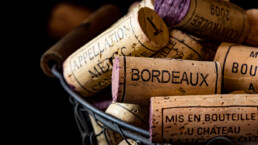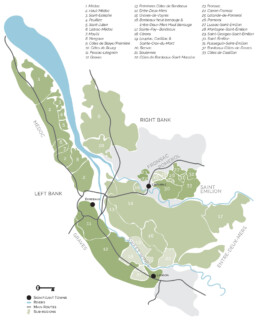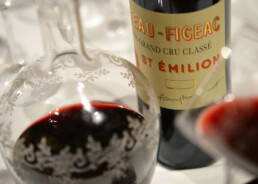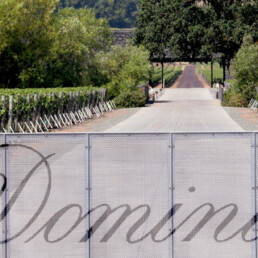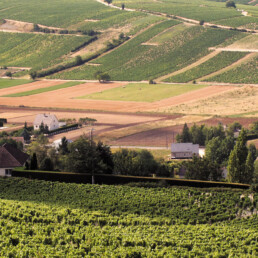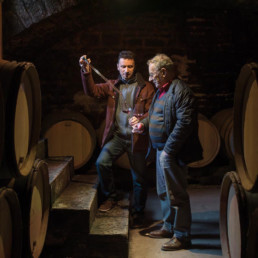Some of the world’s greatest wines hail from the hallowed region of Bordeaux. These incredibly evocative names like Lafite, Latour, Margaux, Mouton-Rothschild, Petrus, Le Pin – and their long histories – give Bordeaux a lustre that few other wine regions can match. From the beginner wine enthusiast to the most knowledgeable connoisseur, great Bordeaux wines are known, sought after, and deservedly loved throughout the world.
Which is why Dhall & Nash is over the moon to Focus On our range of the extraordinary 2016 Bordeaux – these wines are singing! They are magical bottles that deserve thought, time, and your attention. The excellent 2016 vintage brings an even consistency of quality of divine wines at every level – from top classed growth chateaux (100 pointers!) in prestigious appellations of Pauillac, Margaux and St Julien – down to the smallest petit chateaux in lesser-known areas like Cotes de Castillon, Cotes de Francs or Premieres Cotes de Bordeaux. This is great news for Bordeaux lovers at every budget level. It’s time to partake in a deliciously ripe concentrated and elegant Bordeaux without breaking the bank.
What Makes a Great Vintage?
Actually, we should ask firstly, what makes a wine genuinely great? As most wine aficionados know, there’s no straightforward answer to that – the greatness of a wine hinges on a delicate balance of many factors: the producer, the terroir, the grape, the growing conditions, the harvest… One of the most effective markers of a great wine, however, is its vintage year – the year in which a wine’s grapes were harvested. Then ultimately what constitutes a great vintage year depends heavily on the capricious weather.
2016 was “…an excellent year, producing dynamic and well-structured wines that are fresh and balanced. These wines represent the new renaissance of Bordeaux where harmony, refinement and energy are the new keywords for the region.” – James Suckling
Vintage variation is particularly important in Bordeaux. Cellar-worthy vintages can surge in value over generations, or nowadays, often in even less time. In short, for Bordeaux, it helps to know your vintage. Good vintages seem to come every five years, or sometimes two years one after another. Some recent great years include: 1990, 1995, 2000, 2005, 2006, 2009, 2010, 2015, 2016, 2018.
To explain the impact of vintage, Edouard Moueix of famed Chateaux Petrus, elaborates it this way: “The 2016 wines are all aromatic and complex with wonderful fruit concentration, acid balance and reasonable alcohol at 13%. What is most impressive about 2016 is how consistent this vintage is across the board in Bordeaux. In a great year like this, vintages tend to erase terroir, whilst in tricky years terroirs will take over”.
Why is the 2016 Vintage so Special?
The wine critics all concur, red Bordeaux enjoyed an unusual and an exceptional vintage in 2016. In brief, the wet spring, then hot summer and long growing season yielded a crop of wines that, at their best, achieved tremendous flavour intensity while retaining considerable freshness and energy.
“The 2016s are absolutely remarkable wines. The word that comes to mind, unfortunately so often overused, is balance.” – Antonio Galloni, Vinous
At the risk of sounding clichéd, the 2016 vintage was a game of two halves for Bordeaux. The season started wet. Wet being an understatement. There was a lot of rain. In fact, there was record setting amounts of rain through most of June. We’re talking 600-700 mm of water. Everyone was expecting Noah and his ark to sail past!
This created serious disease pressure in the vines. For those working organically and biodynamically, things were even tougher. By the middle of June 2016, according to several growers, the vintage looked like a disaster in the making. Even the vineyards with good drainage were just too wet.
Before the end of June there was just one short period that remained dry. And it just so happened that this dry spell was just long enough for the vines to flower perfectly. Provided the wet weather, which had returned just after flowering, eventually broke, Bordeaux was up for a bumper crop.
Then at the ‘halfway’ mark, everything started to change. Sun, warmth, light, and breezes were exactly what the doctor ordered. What was once looking like a washout was starting to show real promise. As the season progressed, estates were experiencing the complete opposite of what took place at the start of the season. Torrential rains were replaced by drought.
At best, growers experienced a tiny bit of moisture in July and August. The heat and continued lack of moisture initially reduced the levels of acidity, and freshness that is cherished in Bordeaux, especially with the white Bordeaux wines. Vineyards that were able to retain the desperately needed moisture were in great shape for the much needed, second act of the growing season. This meant that the clay with limestone soils on the Right Bank produced the better wine and the gravel hills in the Medoc is where to find the other gems of this 2016 Bordeaux vintage.
As this was one of the driest periods on record for the region – many younger vines suffered. But despite this drought, remarkably, what marks the wines out is their freshness: cool nights and a lack of real heat spikes locked acidity into the grapes. This was going to be a vintage all about balance.
And just as parched vines were crying out for water, good fortune struck again on the 13th of September, as a storm rolled in from the Pyrenees delivering 40mm of rain, which was perfect for the Merlot. At the end of the month, September 30 and October 1, more rain fell which was exactly what the Cabernet Sauvignon needed, and the vintage was close to being made.
The conditions during the harvest, allowed growers to take their time, even though the year was slightly later than ideal. The dry weather continued into October, meaning vignerons could harvest at will, with long hang times preserving even more acidity. But 2016 required more effort during the harvest than usual. This was needed to separate the overly mature fruit, and the grapes suffering from the drought-like conditions during the late summer, from the ripe, fresh grapes. The harvest for some growers continued until late October and even into November for some of the later, cooler terroirs in St. Emilion.
The overall results were overwhelmingly impressive. Given everything that was thrown at Bordeaux in 2016, it does seem that this really was a special vintage!
“It’s not too soon to say that 2016 is a great vintage overall… The wines are full and dense, with ripe tannins and generous fruit. The secret ingredient in the success of these wines is their crisp acidity, and that balance is what makes a great Bordeaux vintage.” – Roger Voss, Wine Enthusiast
Breaking It Down - The Left Bank & Graves:
The 2016 vintage will be particularly celebrated on the Left Bank, with Cabernet Sauvignon benefitting hugely from the long ripening time afforded by glorious weather in September and October. It is in the Médoc’s sweet spot, Pauillac, home to three of the five First Growths, that the vintage reaches its zenith, while the water retaining clay soils of St-Estèphe to the north also performed amazingly. Here, balance is the buzz word: the best wines have ripe fruit, but beautiful chiselled acidity and considerable, yet super-fine tannins. These are wines for the long haul.
And despite the fact that focus will sit squarely on 1,200 hectares of Pauillac, there are impressive wines to be found from Margaux to the top of the Médoc, with lesser wines, whether second wines or Crus Bourgeois, these are showing great quality and drinkability already.
Graves, meanwhile, is again impressive, mirroring some of the best wines of the Médoc. And here there are plenty of wines that will offer outstanding value for money. It remains astounding that this corner of Bordeaux is so often overlooked.
“It is a second coming of age of Bordeaux,” says Mathieu Chardonnier, head of the negociant house of CVBG which also owns a number of top Bordeaux wine estates and sells millions of cases of Bordeaux each year. “It takes confidence to do less to get more in your winemaking and to believe in what you do. But that’s what many of us are doing in Bordeaux now. We made great wines in Bordeaux in 2015 and 2016. They are some of the best ever.”
“Wines with pure fine tannins with beautiful texture and depth of fruit.” – Julie Guinaudeau of prestigious Chateau Lafleur
How the Right Bank Performed:
While the Left Bank will take the acclaim, on the Right Bank too there are gems to seek out. What was crucial – the fruit selection – needed to be careful, as seems universal at all the top estates today. Here, mirroring ripening conditions on the Left Bank, wines with a high proportion of Cabernet Franc or Cabernet Sauvignon have soared.
On the Right Bank, terroir seems particularly important with spots that could deal with the deluge of water early in the season, followed by a severe lack of it later on, proving most successful. So, the celebrated limestone with clay sites of St-Emilion and Pomerol have provided wines that often match, or even surpass, the quality of the celebrated 2015s.
“It’s a year of stunning quality and there are numerous properties that have made the best wine in the history of their estate!” – Jeff Leve, The Wine Cellar Insider
The D&N 2016 Bordeaux Beauties:
The 100 Pointer: 2016 Château Figeac!
It’s here and it’s spectacular!
Neal Martin, of Vinous.com, gave Château Figeac the coveted 100 points and writes: “The 2016 Figeac was bottled at the end of July 2018, since Frédéric Faye wanted to give the wine more time in barrel to develop more harmony. The stunning 24-carat bouquet rivets you to the spot with brilliant delineation and mineral-rich red fruit that articulates its terroir as well as any Right Bank you will find. The palate is medium-bodied with svelte tannin, perfect acidity, wonderfully integrated new oak, and enormous depth toward the fresh, pencil-box- and cedar-infused finish. This is a classic Figeac, up there with the 1947 and 1949, both recently re-tasted and testifying to a wine that genuinely belongs among the elite Saint-Émilions. Faye believes it is the best Figeac he has ever made. He is correct.”
Figeac is one of the great names and terroirs of Saint Emilion whose wines exude class and sophistication rather than just raw power. There have been some serious improvements here recently under winemaker Frédéric Faye and consultant Michel Rolland – but they have not changed the unique Figeac style.
Over the last couple of years, proprietor Madame Manoncourt along with her daughters realised their ‘gold mine’ terroir they were sitting on needed some serious investment in the reconstruction of the estate and its winemaking facilities. And as big as the estate is (the largest in St. Emilion), it was going to be quite the project but the early results from their investment have come in and they are, literally, perfection. The 2016 Château Figeac is sublime!
Modern techniques such as vibrating sorting tables, de-stemming and an optical laser sorting line are being used, as well as 100% new oak barrels from 7 different coopers. As a consequence, the wines produced now seem a little riper and more polished than before but are still fine, pure, and classic. Unusually for the Right Bank there is only 30% Merlot in the vineyard with 35% Cabernet Franc and – rarer still – 35% Cabernet Sauvignon.
If you ask any of the top professionals in Bordeaux which estate they’d like to own, Château Figeac would be at the top of many lists. Why? Because it is one of the estates that is in “The Golden Triangle”. Other than the Cote (Pavie, Ausone), the triangle is the best terroir of the region. What makes this area so special is a gravel bed that runs from Cheval Blanc to Figeac, prime for growing Cabernet-based grapes, which is not the norm for the Right Bank. When explaining this anomaly of growing Cabernets in St. Emilion, the legendary winemaker and proprietor, Christian Moeuix (of Ch. Petrus, Lafleur, Dominus) said that only the Golden Triangle is the place to grow Cabernet grapes.
“Each plot and each grape variety, once fully expressed, brings a new element to the rich canvas created every year at blending, giving birth to a remarkable succession of great wines.” Chateau Figeac website
Brandon’s TOP of the Pops for D&N’s 2016 Bordeaux: Here our so-called “Super Seconds”. A category ideal for you discerning wine lovers with, say, mortgages to pay and kids in school
The All-Rounder: 2016 Château Brane-Cantenac ‘Le Baron de Brane’ – Margaux
“Love the fruit on the centre palate here with its brightness and vivid acidity. Citrus undertones and a fresh finish. Well done here, and it’s a second wine.” 93/100 points, James Suckling
“Brane-Cantenac’s 2016 Baron de Brane is a silky, gracious second wine from Brane-Cantenac that is ideal for drinking now and over the next handful of years. Expressive floral and savoury notes add brightness to a core of sweet red berry and plum fruit. The 2016 is delicate and a touch lithe in the glass, with superb balance and tons of sheer immediacy.” 90/100 points, Antonio Galloni, Vinous
The Cellar Superstar: 2016 Château Haut-Bailly La Parde de Haut-Bailly – Graves
“This second wine of Haut-Bailly… is packed with blackberry and black plum fruits. The richness is contrasted by the firm structure at the back of the wine. Dark tannins and ripe acidity support the fruitiness.” 94/100 points, Wine Enthusiast
“The 2016 La Parde de Haut-Bailly is a blend of 47% Merlot, 47% Cabernet Sauvignon and 6% Cabernet Franc. It has a typical bouquet for the vintage with black fruit, smoke, and a touch of bay leaf, a little reserved at first but opening with time. The palate is medium-bodied with fine tannin on the entry. The Merlot imparts a lot of vigour into this Deuxième Vin, which is a feisty little number with great tension on the finish, cedarwood and tobacco lingering on the aftertaste. This comes recommended.” 92/100 points, Robert Parker’s Wine Advocate (NM)
The Ready-to-Drink: 2016 Château Cos d’Estournel Les Pagodes de Cos – Saint Estephe
“Proof that in the great vintages, the smart money should be seeking out second wines of classified growths for wines that are guaranteed to deliver. This is packed with spice, chocolate, opulent in texture with an unmissable gourmet edge, given definition by a precise edge of cassis bud and liquorice, and a better balance overall than the 2010 Pagodes, although both are delicious wines. 0.5% Cabernet Franc completes the blend. Drinking Window 2021 – 2036” 93/100 points, Decanter (Jane Anson)
“A red wine with very deep and intense fruit character, yet rich tannins to back it up. Full-bodied, layered, and powerful. Best from 2021 through 2031.” 94/100 points, James Suckling
The Multi-Format: 2016 Château Pichon-Longueville ‘Les Griffons de Pichon Baron’ – Pauillac (available in 375ml, 750ml, 1.5L)
“This is closer to the signature of the grand vin than that of the Tourelles de Longueville as it comes from soil with a higher gravel content. It represents 30% of production. Beautiful, rich dark purple in colour from a blend of 52% Cabernet Sauvignon and 48% Merlot, a more classic interpretation of a Médoc second wine than Les Tourelles. This is gorgeous, with a sense of restraint behind the deep, plump fruit. 18 months in 60% new oak reinforces the silky tannins. I like this very much. Drinking Window 2027 – 2050.” 91/100 points, Decanter (JA)
“This is fleshy and caressing in feel, letting warm plum sauce and cassis notes roll along, lined with pretty violet and anise accents. There’s a light tug of earth through the gently toasty finish, but this is pretty much all fruit and is ready to go. Drink now through 2030.” 91/100 points, Wine Spectator (JM)
As Jean-Michel Cazes of Chateau Lynch-Bages says, this is possibly the most unique vintage in his career: “In terms of colour, concentration, and tannin I have never seen anything like it,”
Wine Geek Talk Time:
What’s the Bordeaux ‘advantage’?
It’s location. The ice age certainly did Bordeaux some favours, leaving behind an environment that can only be described as a wine-growing paradise. In fact, the success of Bordeaux can largely be linked to the incredible soil structure it sits on and its geographical location on the western seaboard of France.
It has a variety of clay, limestone, gravel, and siliceous soil which makes up this diverse yet geologically perfect landscape. And with a significant mineral content to nourish the vines. With two major rivers (Garonne and Dordogne) running through the centre of Bordeaux and an array of tributaries from the Gironde Estuary, Bordeaux is home to an incredible watershed with ample groundwater, perfect for winemaking. This system of rivers feeding into the Gironde estuary also helped put Bordeaux wines on the map historically, by providing a bustling port with easy access to the ocean and, thus, important foreign markets. The moderating effect of the coastal gulf stream creates a near-perfect maritime climate. Thus, Bordeaux is blessed with temperate winters and long, warm summers that are ideal for growing grapes.
The Garonne and Dordogne Rivers divide the Bordeaux region into its sub-regions, each of which is home to several appellations. Altogether, there are 60 appellations in Bordeaux, which is also the greatest producer of appellation wines in France.
The High Rent Districts:
In any discussion on Bordeaux, you may have heard the terms ‘Left bank’ and ‘Right Bank’ bandied about. They are unofficial terms that are used widely to describe the rather different bits of Bordeaux either side of the Gironde estuary/river that slices through the region, splitting by the time it reaches the city of Bordeaux to form the Dordogne and Garonne rivers (like an inverted ‘Y’).
The Left Bank can be broken down into three main regions: Médoc, Haut-Médoc and Graves. The most famous ones have their own unique and distinct style. Cabernet Sauvignon is the star grape variety, flourishing in the Left Bank’s gravel soils, which capture the warmth of the sunshine during the day and transmit it to the vines during the night.
The wines of the Left Bank are known for their magnificent personality. The red blend tends to be comprised, in order of importance, by Cabernet Sauvignon, Merlot, Cabernet Franc, Malbec and Petit Verdot. These wines tend to be bold and tannic, with remarkable ageing potential, although styles vary from one appellation to another. Signature aromas include dark fruit, cigar box, cedar, truffles, leather, and spices with age. These legendary wines are designed for cellaring.
“The tannins are extraordinary, refined and sophisticated,” says Thomas Duroux, CEO of Château Palmer in Margaux
Margaux (Haut-Médoc): described as charming when well made, the style is perfumed, floral, with a silky texture. This is considered the feminine version of Left Bank Bordeaux.
Pauillac (Haut-Médoc): concentrated, with distinct aromas of cassis, cedar, and tobacco. This is the masculine version of Bordeaux in the Left Bank.
St-Estèphe (Haut-Médoc): deeply coloured, tannic, austere when young, but with a great ageing potential.
St-Julien (Haut-Médoc): perceived as the commune for wine connoisseurs who seek subtlety, it is somewhere in between all the three wines above.
Pessac-Léognan (Graves): this commune can produce both red and white wines, compared with the others in this list, which are red wine only. The reds of Pessac-Léognan have a distinct mineral, earthy aroma, topped with smokiness.
On the Right Bank, things are a bit simpler here with just two main notable communes: the appellations of Saint- Émilion and Pomerol. These were not included in the 1855 classification.
Here, because of the rather different soils, the Merlot grape variety is king. It’s frequently blended with Cabernet Franc, but the majority of wines are Merlot-dominant. The top right bank properties used to be in the shadow of the classed growths, but this has changed, and now the most sought-after wines cost as much as the First Growths do. (Angelus, Petrus, LaFleur, Cheval Blanc)
Pomerol: a small commune, but distinctive, which produces glamorous and opulent wines dominated by top quality Merlot.
Saint Émilion: wines have moderate to high tannins, but a soft and rich mouthfeel, and complex red berry fruit and plum aromas. These are blends mix Cabernet Franc and Merlot in various proportions.
The wines of the Right Bank come from soils predominantly composed of red clay, gravel, and limestone, with the exception of Pomerol, whose vines are planted in soils of gravel, clay, and sandy soil.
And More Wine Geek Talk:
Highly Classified! Trying to Understand the Bordeaux Classifications Without Falling Asleep:
Wine laws in Europe have a reputation for being incredibly complicated. Bordeaux holds its fair share of the blame for this, with three different systems used to identify the quality of the region’s appellations. But in hindsight, the classification of the wines of Bordeaux proved to be an international marketing success. It was the first of its kind and quickly increased demand and prices for the best classified Bordeaux wines.
The Bordeaux appellations were famously classified in 1855, on the basis of the properties which consistently fetched the highest prices at the time. This classification had five tiers of ‘Growths’, with the celebrated ‘First Growth’ Châteaux (Latour, Margaux, Lafite, Haut Brion) at the top, and then Second, Third, Fourth and Fifth growth properties following.
The classification has proved remarkably resilient: while Bordeaux has changed quite a bit as a region in the intervening 160-odd years, the classed growths, which represent the elite of Bordeaux properties, remain at the fore. Of course, there are some Fifth Growths which now outperform third growths, and several properties could be marked as over- or under-achievers in their class, but the classification still matters in the marketplace. Only one significant change has occurred: in 1973, Château Mouton Rothschild was promoted from Second to First Growth status.
A favourite discussion point among wine geeks is which of the leading Left Bank estates could also be promoted to First-Growth status: Château Palmer in Margaux, Cos d’Estournel in Saint-Estèphe and Léoville Las Cases in St Julien could be contenders, as could the ever-reliable Léoville Barton.
Further south, Sauternes producers also got a classification system in 1855, devised alongside the one in Médoc as part of celebrations around the Exposition Universelle de Paris that year. Producers were split into First and Second growths – or Premiers and Deuxièmes crus classés – but Château d’Yquem was given special dispensation as a ‘Premier Cru Supérieur’.
The Left Bank is also home to the Cru Bourgeois classification, which was also relaunched as a three-tier system. A classification for dry red and white Graves wines was devised in 1953 and finalised in 1959. It includes 16 cru classé estates, all of which sit inside the Pessac-Léognan appellation today.
On the 2016 vintage “The wine has ripeness as well as energy,” says Hubert de Bouärd, Château Angélus, Saint-Émilion.
On the Right Bank, Pomerol has no classification system but is home to several small yet mighty estates including the legendary Château Petrus. While Saint-Emilion is split up into top-level Premier Grand Cru Classé wines, which are further split into an A category (the best) and a B category. Below that come Grand Cru Classé wines and finally Grand Cru. The St-Emilion Classification was first introduced in 1955. Unlike the 1855 Classifications, this ranking is frequently reviewed, currently every 10 years. The next one is due in 2022.
In the 2012 list, 82 estates were divided into 64 Grand Cru Classé estates and 18 Premier Grand Cru Classé properties – themselves separated into ‘A’ and ‘B’ rankings. Château Angélus and Château Pavie joined Ausone and Cheval Blanc as Premier Grand Cru Classé A estates in 2012. Beyond this, you will also see bottle labels stating ‘St-Emilion Grand Cru’, which is just an appellation.
Luckily for us, there are compelling, classy wines on both the Left and Right Banks. Also, and unusually for top Bordeaux vintages, there is a readiness to drink. Of course, some 2016s will need at least 10 years to start their drinking peak. But some of the Cru Bourgeois and humbler Bordeaux Superieur are approachable and ready to drink right now.
After big blockbuster vintages such as 2005, 2009 and 2010, this is a return to what the Bordeaux vignerons do best: producing wine with power, concentration, and with freshness. Although the wines possess the characteristics of a hot vintage – dark, deep colours, ripe fruit, and structure – there is a drinkability to these wines which makes them absolutely glorious to taste.
“The [2016] wines are positively electric and energizing” – Antonio Gallon, Vinous
Further, what makes the 2016 vintage so special is the quality across the Bordeaux hierarchy. The same character found in the most complex wines is also apparent in the simpler options. They all offer bottlings with rich, ripe fruit and a tannic structure that promises longevity. When discussing this extraordinary 2016 vintage, wine buffs and critics will focus most of their attention on Bordeaux’s big guns. But for our savvy D&N devotees, you will find much to like among the more modestly priced wines of 2016. When it comes to quality, value and availability, no region in the world can match Bordeaux.
Take it from the experts like James Suckling who writes: “To conclude, I want to buy a number of wines in 2016 just like I did in 2015. And I recommend you do the same if you love excellent Bordeaux. The two vintages produced wines that are incomparable to other reds made in the world. And the wonderful balance, intensity and clarity of the wines are so, so Bordeaux today”.
Don’t be a slow poke – NOW is the time to top up your cellar with some vinous gems from the superb Dhall & Nash 2016 Bordeaux offering. These wines manage to combine a hedonistic powerful appeal whilst being calmingly thought-provoking, demanding you slow down before you’ve gulped the whole glass and are opening another bottle!
In the 2016 Bordeaux vintage “I have so far tasted some absolutely stunning reds; I have even been tempted to give a few scores of 19 out of 20 – virtually unheard-of for me!” – Jancis Robinson.
Browse our full range of 2016 Bordeaux beauties below and get in touch if you’d like to place an order: orders@dnfinewine.com.
| Brand | Product Name | Sub Region | Stock | Normal Retail Price | Price ex GST |
|---|---|---|---|---|---|
| Château Angélus | 16 Château Angelus | Saint-Émilion | 6 | $1,239.01 | $695.00 |
| Château Brane-Cantenac | 16 Baron de Brane Margaux | Margaux | 36+ | $81.82 | $58.44 |
| Château Brane-Cantenac | 16 Baron de Brane Margaux 375ml | Margaux | 36+ | $40.91 | $29.22 |
| Château Clinet | 16 Fleur de Clinet | Pomerol | 36+ | $106.03 | $75.74 |
| Château Clinet | 16 Pomerol by Clinet | Pomerol | 8 | $73.31 | $52.65 |
| Château Cos d'Estournel | 16 Cos d'Estournel Les Pagodes de Cos | Saint-Estèphe | 18 | $139.98 | $99.98 |
| Château d'Yquem | 16 Château d'Yquem 375ml | Sauternes | 21 | $570.00 | $325.00 |
| Château Ducru-Beaucaillou | 16 Château Ducru-Beaucaillou | Saint-Julien | 12 | $593.14 | $385.00 |
| Château Ducru-Beaucaillou | 16 La Croix de Beaucaillou | Saint-Julien | 30 | $143.91 | $102.79 |
| Château Figeac | 16 Château Figeac | Saint-Émilion | 12 | $600.00 | $395.00 |
| Château Gruaud-Larose | 16 Sarget de Gruaud Larose | Saint-Julien | 11 | $80.00 | $57.90 |
| Château Haut-Bailly | 16 La Parde de Haut-Bailly | Pessac-Léognan | 36+ | $100.68 | $71.97 |
| Château L'Église Clinet | 16 Château L'Eglise Clinet | Pomerol | 6 | $905.00 | $595.00 |
| Château La Conseillante | 16 Château La Conseillante | Pomerol | 12 | $600.00 | $395.00 |
| Château La Gaffelière | 16 Clos La Gaffeliere | Saint-Émilion | 36+ | $67.67 | $48.34 |
| Château Léoville-Las Cases | 16 Le Petit Lion du Marquis de Las Cases | Saint-Julien | 36 | $155.70 | $111.21 |
| Chateau Marjosse | 16 Château Marjosse Rouge | Entre-deux-Mers | 36+ | $45.00 | $30.00 |
| Château Pichon Baron | 16 Les Griffons de Pichon Baron | Pauillac | 22 | $133.44 | $95.32 |
| Château Pichon Baron | 16 Les Griffons de Pichon Baron 1.5L | Pauillac | 3 | $262.24 | $188.74 |
| Château Pichon Baron | 16 Les Griffons de Pichon Baron 375ml | Pauillac | 36+ | $70.00 | $47.18 |
| Château Pichon Longueville Comtesse de Lalande | 16 Château Pichon Longueville Reserve de la Comtesse 375ml | Pauillac | 36+ | $65.00 | $47.18 |
| Château Smith Haut Lafitte | 16 Château Smith Haut Lafitte Rouge | Pessac-Léognan | 2 | $298.00 | $195.00 |
| Château Troplong Mondot | 16 Château Troplong Mondot | Saint-Émilion | 36+ | $102.00 | $72.86 |
| Château Valandraud | 16 Virginie de Valandraud | Saint-Émilion | 32 | $121.90 | $87.07 |
| Brand | Product Name | Sub Region | Stock | Normal Retail Price | Price ex GST |
|---|---|---|---|---|---|
| Château Angélus | 16 Château Angelus | Saint-Émilion | 6 | $1,239.01 | $695.00 |
| Château Brane-Cantenac | 16 Baron de Brane Margaux | Margaux | 36+ | $81.82 | $58.44 |
| Château Brane-Cantenac | 16 Baron de Brane Margaux 375ml | Margaux | 36+ | $40.91 | $29.22 |
| Château Clinet | 16 Fleur de Clinet | Pomerol | 36+ | $106.03 | $75.74 |
| Château Clinet | 16 Pomerol by Clinet | Pomerol | 8 | $73.31 | $52.65 |
| Château Cos d'Estournel | 16 Cos d'Estournel Les Pagodes de Cos | Saint-Estèphe | 18 | $139.98 | $99.98 |
| Château d'Yquem | 16 Château d'Yquem 375ml | Sauternes | 21 | $570.00 | $325.00 |
| Château Ducru-Beaucaillou | 16 Château Ducru-Beaucaillou | Saint-Julien | 12 | $593.14 | $385.00 |
| Château Ducru-Beaucaillou | 16 La Croix de Beaucaillou | Saint-Julien | 30 | $143.91 | $102.79 |
| Château Figeac | 16 Château Figeac | Saint-Émilion | 12 | $600.00 | $395.00 |
| Château Gruaud-Larose | 16 Sarget de Gruaud Larose | Saint-Julien | 11 | $80.00 | $57.90 |
| Château Haut-Bailly | 16 La Parde de Haut-Bailly | Pessac-Léognan | 36+ | $100.68 | $71.97 |
| Château L'Église Clinet | 16 Château L'Eglise Clinet | Pomerol | 6 | $905.00 | $595.00 |
| Château La Conseillante | 16 Château La Conseillante | Pomerol | 12 | $600.00 | $395.00 |
| Château La Gaffelière | 16 Clos La Gaffeliere | Saint-Émilion | 36+ | $67.67 | $48.34 |
| Château Léoville-Las Cases | 16 Le Petit Lion du Marquis de Las Cases | Saint-Julien | 36 | $155.70 | $111.21 |
| Chateau Marjosse | 16 Château Marjosse Rouge | Entre-deux-Mers | 36+ | $45.00 | $30.00 |
| Château Pichon Baron | 16 Les Griffons de Pichon Baron | Pauillac | 22 | $133.44 | $95.32 |
| Château Pichon Baron | 16 Les Griffons de Pichon Baron 1.5L | Pauillac | 3 | $262.24 | $188.74 |
| Château Pichon Baron | 16 Les Griffons de Pichon Baron 375ml | Pauillac | 36+ | $70.00 | $47.18 |
| Château Pichon Longueville Comtesse de Lalande | 16 Château Pichon Longueville Reserve de la Comtesse 375ml | Pauillac | 36+ | $65.00 | $47.18 |
| Château Smith Haut Lafitte | 16 Château Smith Haut Lafitte Rouge | Pessac-Léognan | 2 | $298.00 | $195.00 |
| Château Troplong Mondot | 16 Château Troplong Mondot | Saint-Émilion | 36+ | $102.00 | $72.86 |
| Château Valandraud | 16 Virginie de Valandraud | Saint-Émilion | 32 | $121.90 | $87.07 |
